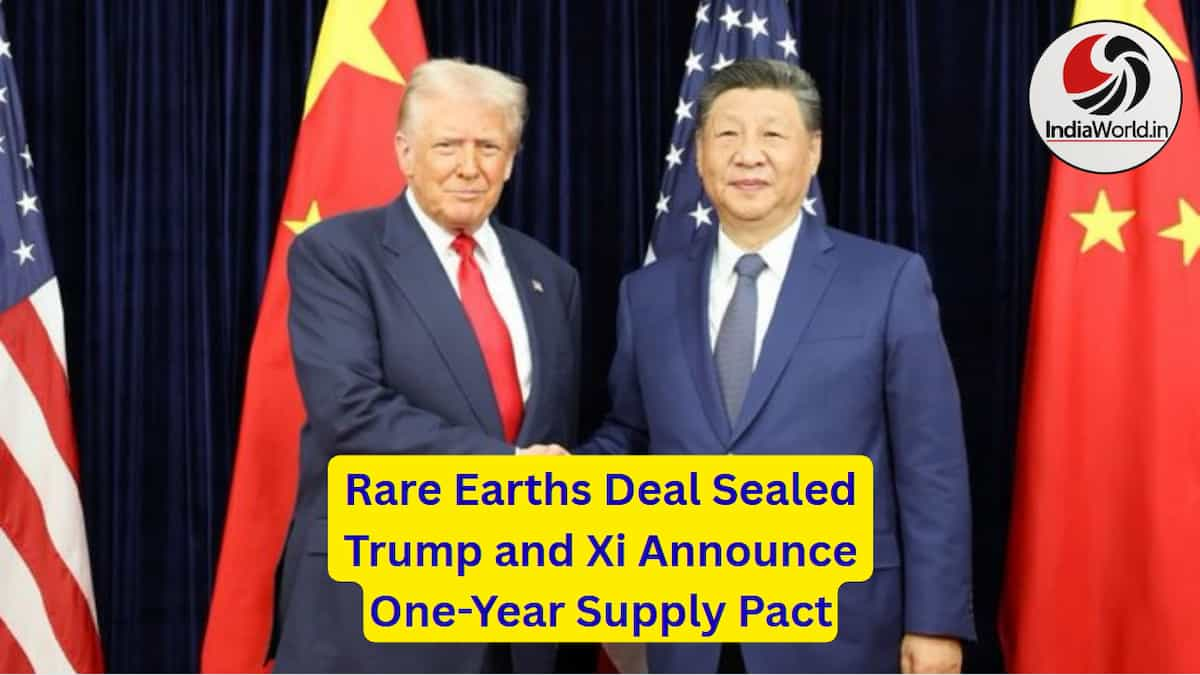US-China Trade Deal Breakthrough: Tariffs Cut After Xi Meeting
In a dramatic shift in global trade dynamics, US President Donald Trump announced a reduction in tariffs on Chinese goods from 57% to 47% following what he called an “amazing” meeting with Chinese President Xi Jinping in South Korea. The summit, held on October 30, 2025, marked the most significant easing of tensions between Washington and Beijing since Trump’s return to office.
The leaders discussed a wide range of issues, including trade, technology, fentanyl trafficking, rare earth exports, and semiconductor cooperation. Trump revealed that China would immediately resume large-scale purchases of American soybeans, a move welcomed by US farmers and global markets alike.
US-China Tariff Cuts and Rare Earths Deal
One of the most impactful outcomes was the extendable one-year agreement on rare earth supply, which Trump said was “settled for the world.” Rare earths are critical for manufacturing semiconductors, electric vehicles, and defense equipment. The deal is expected to be renegotiated annually, ensuring continued cooperation.
Additionally, fentanyl-related tariffs on China were slashed to 10%, as Xi pledged to intensify efforts to curb the export of precursor chemicals used in the drug’s production.
“We’re going to be providing conclusions on very important things,” Trump told reporters aboard Air Force One
Broader Cooperation: Semiconductors, Ukraine, and More
The summit also touched on semiconductor supply chains, with Trump noting that China would engage with companies like Nvidia to discuss chip imports. However, he clarified that Blackwell chips were not part of the discussion.
On geopolitical matters, Trump and Xi agreed to work together on Ukraine, although details remain sparse. Interestingly, Taiwan was not discussed, a notable omission given its strategic importance.
Trump’s Asia Tour and Future Visits
The meeting was part of Trump’s broader Asia tour, which included stops in Cambodia and Thailand, aimed at expanding US trade influence in the region. Trump confirmed he would visit China in April 2026, with Xi expected to make a reciprocal trip to the US later that year.
Xi Jinping’s Call for Long-Term Cooperation
Chinese state media reported that Xi urged both nations to focus on long-term cooperation rather than retaliation. He emphasized that China “never wanted to challenge or replace anyone” and called for shortening the list of problems while lengthening the list of collaborative efforts
Xi also highlighted potential cooperation in energy, telecom fraud prevention, and anti-money laundering, signaling a broader scope beyond trade.

From Trade War to Truce: A Timeline
- Feb 1, 2025: Trump imposed 10% tariffs on all Chinese imports, citing fentanyl concerns.
- April 2025: Tariffs escalated above 100% on both sides.
- May 2025: Geneva meeting led to a 90-day truce.
- Summer 2025: Talks in London and Stockholm extended the truce.
- Oct 2025: Trump threatened 100% tariffs; China tightened rare earth export licenses.
- Oct 30, 2025: Trump-Xi summit in South Korea led to tariff cuts and new agreements.
Behind the Scenes: Fentanyl Trade Link
According to the Wall Street Journal, the deal was framed around reducing US tariffs in exchange for China’s commitment to curb fentanyl precursor exports. The understanding was finalized during the leaders’ summit, with follow-up negotiations expected
US Treasury and Trade Officials React
US Treasury Secretary Scott Bessent called the framework “very successful,” while Trade Representative Jamieson Greer met with Chinese Vice Premier He Lifeng and negotiator Li Chenggang in Kuala Lumpur for the fifth round of talks. Bessent confirmed that China would resume soybean purchases and that the truce would likely be extended
Beijing’s Measured Response
Chinese officials remained cautious. Li Chenggang noted “intense consultations” and emphasized that China would proceed through domestic approval processes. He added, “The US position has been tough, whereas China has been firm in defending its own interests.”
🌏 Strategic Expansion in Asia
At the ASEAN Summit in Kuala Lumpur, Trump announced new economic frameworks with Cambodia, Thailand, and Malaysia, focusing on critical minerals. This move is seen as part of Washington’s strategy to reduce dependence on China while expanding its trade footprint in Asia.
🔗 External Sources
Read also : Income Tax Deadline Extended: CBDT Gives Firms More Time
❓ FAQs: Why Does the USA Need China’s Rare Earth Minerals?
1. Why are rare earth minerals important to the United States?
Rare earths are essential for manufacturing semiconductors, electric vehicles, defense systems, and renewable energy technologies. They power everything from smartphones to fighter jets.
2. Why does the US rely on China for rare earths?
China controls over 60% of global rare earth production and refining capacity. The US lacks sufficient domestic infrastructure to mine and process these minerals at scale.
3. What happens if China restricts rare earth exports?
Export restrictions can disrupt global supply chains, increase costs for US manufacturers, and delay production of critical technologies like EVs and military equipment.
4. Is the US trying to reduce dependence on China for rare earths?
Yes. The US is investing in domestic mining, recycling, and partnerships with countries like Australia and Canada. However, building a full supply chain takes time.
5. What was agreed in the Trump-Xi meeting about rare earths?
Trump and Xi agreed on a one-year extendable deal for rare earth supply, easing tensions and ensuring continued access for US industries.








